The 13.3 billion dollar Uss Gerald R Ford is the largest and most expensive warship ever to sail.
It boasts a sprawling five-acre flight deck and new technologies aimed at making it- and carriers like it- the world’s most powerful, well into 2050 and Beyond.
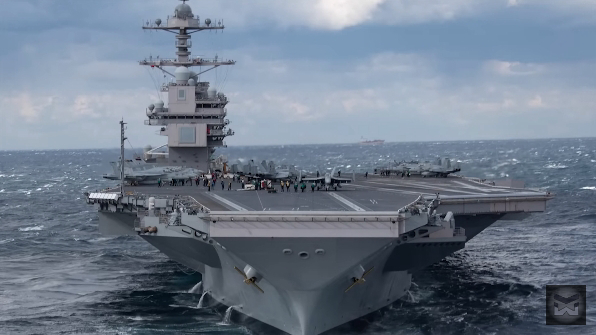
The Vessel holds four squadrons of Fighters on board and a bevy of support and tactical aircraft- more than 60 planes in all, though it can accommodate as many as 90.. the Uss Ford stands more than Nine Stories above the water line and weighs 97 000 tons, that’s 32 000 tons heavier than the largest battleships of World War Ii.
But big doesn’t mean slow.
Powered by a pair of advanced a1b nuclear reactors, the ship has nearly three times the power of America’s existing super carriers: about 300 megawatts of electrical power in all, according to the Navy.
34 MILES PER HOUR
Seeing it on the water is like watching a New York City Block cruise passed at 34 miles per hour but new anti-ship missiles from China, some capable of maneuvering at Hypersonic speeds above Mach 5, threaten to render the Uss Ford and the Navy’s entire Pacific Fleet obsolete.
A sobering report from the Congressional research service, updated in August 2022, points to concerns about the survivability of Navy surface ships in potential combat situations against adversaries such as China that are armed with large numbers of uavs and anti-ship missiles, including Advanced models.
China has aggressively scaled the size of its naval fleet in the past decade and has developed several anti-ship weapons, including highly maneuverable Hypersonic missiles capable of reaching Mach 10..
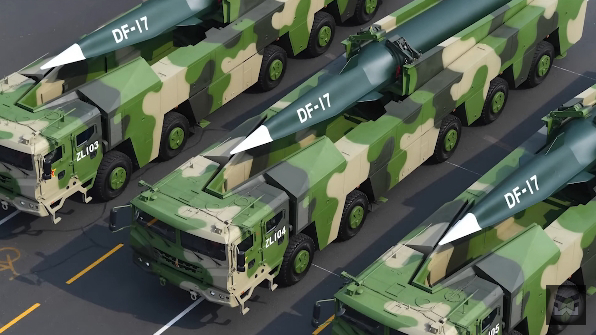
China isn’t hiding the fact that those weapons are intended to repel American ships.
The Uss Ford and ships like it have a battery of anti-missile defenses, but none are capable of protecting it in a prolonged battle against China’s latest weapons.
To maintain dominance in the Pacific, to just keep its ships afloat, the Navy is going all in on a new technology that has remained Out Of Reach for decades: the laser.
The benefits are tantalizing: powered by a large fuel source, the Ford’s hulking nuclear reactors fit the bill.
Lasers fire at the speed of light, negating the speed of hypersonic weapons.
They can reload quickly to fend off swarms of drones, and they don’t require stores of ammunition, giving ships nearly unlimited firing opportunities.
In 2021, the Biden Administration formed a Pentagon task force to assess the threat posed by China’s rapid Naval expansion.
One year later, based on the task Force’s findings, the Department of Defense declared China as America’s most consequential strategic competitor.
China now has a fleet of more than 770 Naval, Coast Guard and other military vessels.
That’s more than twice the size of America’s Fleet and it’s concentrated almost entirely in the Pacific, whereas the Us Fleet is dispersed between the Atlantic and Pacific regions.
China’s strength is also bolstered by an arsenal of advanced anti-ship weapons, which it can launch from ground bases, warships and aircraft.
The most potent are its long-range missiles like the Df-21d and df-26, but the most fearsome is the dfzf, a Hypersonic missile that can reportedly reach speeds of mach
10- an attack from more than 1500 miles away.
China’s Hypersonic weapons aren’t the only threats.
Carrier commanders have long understood their vulnerability to batteries of anti-ship cruise missiles.
When fired in high numbers, the weapons can overwhelm the ship’s defenses.
Swarms of relatively cheap long-range suicide drones could a carrier group just as easily replace airplanes for drones and high-speed missiles.
And the Navy’s predicament becomes clear.
Its largest carriers and most heavily armed destroyers aren’t equipped to defend against throngs of Invaders descending from the air.
Today, the Uss Gerald R Ford Sales, with what’s called a carrier strike group, an armada of Tanner more Cruisers, destroyers and frigates, and sometimes a submarine or two.
At least two of those vessels specialize in air defense, usually Arleigh Burke class guided missile Destroyers, these ships provide the first layer of protection against enemy attacks, using powerful on-board Radars to detect targets more than 200 miles away.
CLOSE-IN WEAPON SYSTEM4.500 ROUNDS PER MINUTE
The ships are armed with surface-to-air missiles and the Navy’s Phalanx Sea Whiz close-in weapon system, which operates a radar-controlled 20 millimeter six barrel Gatling cannons that fire 4 500 rounds per minute
All told, a carrier strike group has enough Hardware to intercept dozens of inbound missiles from as far away as 200 miles, but it becomes defenseless as soon as the ships run out of interceptors to fire, which must be stored and then restocked after the battle.
Some Munitions can be replenished at Sea, while missiles must be resupplied back at Port.
The Pentagon calls this a depth of magazine problem, something enemies can exploit with swarming attacks.
The Pentagon believes that powerful lasers are the best defense against swarming drones.
Unlike blasters in Star Wars, laser beams don’t explode when they hit a Target.
Instead, they deliver intense Heat at lower power output.
Lasers can confuse the optical sensors on a drone, increase the power and a laser will burn a hole through it.
Essentially, lasers turn energy into ammo.
Powered by nuclear reactors like those on the Uss Ford, they can potentially fire thousands or even tens of thousands of times at incoming munitions.
And because laser beams travel at the speed of light.
Lasers can track and Target unpredictable weapons like China’s Hypersonic Df Zf better than conventional missiles.
Gunners won’t have to lead a Target and anticipated its location the way they do currently.
The Pentagon likes their low cost too.
The Congressional research service estimates that firing a high-powered laser will cost somewhere between one dollar and ten dollars- just a fraction of the 1 million to 10 million dollars that defensive missiles cost.
Using million dollar missiles to fight off swarms of relatively cheap enemy drones or cruise missiles is what those analysts call a negative cost exchange ratio.
In 2014, the Navy installed the first laser on a ship for sea trials.
Fitted forward on the deck of the amphib transport ship, the Uss Ponce, the 33 kilowatt and sec-3 laser weapon system laws has a short round firing tube painted white.
Two smaller tubes for sensors rest on the shoulders.
To an untrained eye, it looked like an amateur astronomer’s telescope, but even this early low power version delivered striking Firepower.
A second, stronger laser entered trials in 2019.
Then, in August 2022, the Navy installed its first permanent laser on a destroyer, the Arleigh Burke class Preble developed by Lockheed Martin.
The weapon has a 60 kilowatt power output that integrates with the ship’s Advanced Aegis radar and weapons control system.
The Navy calls it Helios, or high energy laser, with integrated Optical dazzler and surveillance system.
Later versions could be even more powerful.
Lockheed Martin says the weapon could eventually scale to 150 kilowatts.
But even at that strength it will be most useful Against drones and small surface ships to stop a barrage of cruise missiles or a Hypersonic weapon barreling toward the Uss Ford at Mach 5 or faster.
The Navy needs something much more powerful to thwart cruise missiles.
300-KILOWATT LASER
The Navy estimates that it needs at least a 300 kilowatt laser, in addition to the size and speed of those missiles.
Their nose cones are made out of such materials as pyrolytic graphite or pyro serum Ceramics, designed to withstand the high heat inherent to supersonic flight, which can top 1000 degrees Fahrenheit.
Lasers will have to fire with enough intensity to rapidly burn through those heat resistant substances.
They also need enough power to overcome the effect of atmospheric turbulence on the laser.
Finally, they require quick identification of the precise Target point on an inbound missile traveling at one mile per second to take it out.
That weapon appears to be on the way.
The Navy plans to begin testing a 300 kilowatt weapon as early as next year and cause the experimental weapon Hellcat for high energy laser counter Ascm program.
A 2020 photo taken of a Wall board behind chief of Naval operations Admiral Michael Gilden appears to show that the Hellcat test bed will be based on the Navy’s existing and sec-4 Optical dazzler interdictor system, which is already being fielded on some destroyers.
If successful, the platform will be the Navy’s first laser capable of shooting down incoming anti-ship cruise missiles.
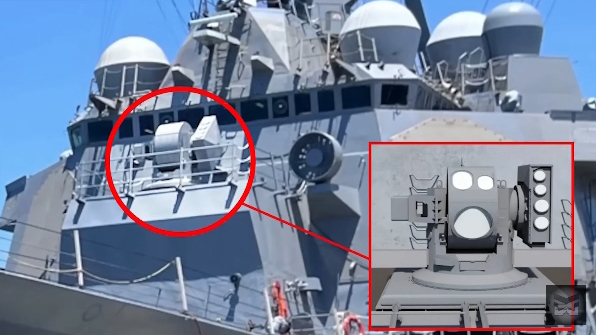
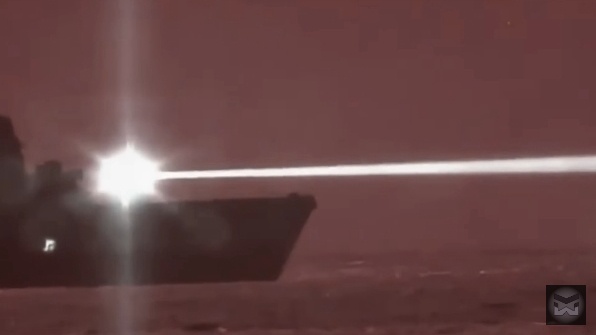
Even Hellcap won’t be enough to stop Hypersonic missiles flying at speeds up to Mach 10.. those weapons are manufactured to withstand temperatures of 1700 degrees Fahrenheit or hotter.
The Pentagon believes it may take a one megawatt laser- more than three times the power of Hellcat- to stop them, but megawatt class lasers may not be too far off either.
The Navy awarded a contract to Northrop Grumman to develop such a laser, and in July 2022 the company completed a preliminary design of a high energy laser that combines several laser beams into one powerful Ray.
For the Pentagon, which has billions invested in aircraft carriers, that technology can’t arrive soon enough, given the rapid emergence of China’s anti-ship weapons.
Warships like the Uss Ford are more vulnerable than they have been in 80 years.
The fate of the world’s most powerful navy could be decided by a single, well-aimed Hypersonic shock, but no matter how fast or powerful anti-ship missiles become.
The Navy hopes its futuristic lasers can burn them out of the sky for less than the cost of a cup of coffee.
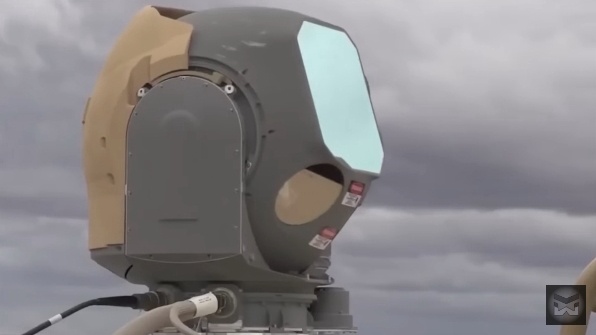
What do you think of the powerful lasers on the new Ford class aircraft carriers?
Let us know in the comments below if you enjoyed this video.
Don’t forget to give us a like And subscribe to military world to get our latest videos straight to your notifications.





